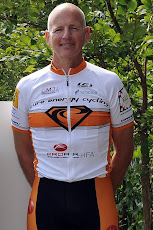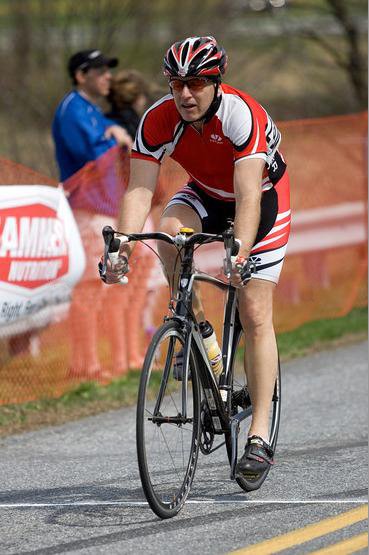What is Cycling Fitness and how does one improve it? Cycling fitness is comprised of many fitness elements. And, the word "fitness" alone means different things to different people. For me, cycling fitness is about getting stronger on the bike. Stronger means being able to ride FASTER and LONGER. The important thing is how to train to improve ones performance. Before I discuss how to train, here's what Cycling Fitness entails:
Cycling Fitness = Muscle-strength + Endurance + Neuromuscular + Aerobic + Anaerobic + Power + Other
These fitness elements are involved in every aspect of our riding..whether it's training or racing. In the early-season, you SHOULD BE working on the more general fitness elements to increase Muscular-strength in your legs via Isolated Leg Training and resistance training. Additionally, you should work on Neuromuscular fitness via hi-speed skill drills. Finally, you should work on your Endurance..the long steady rides. i.e. the 2-3 hr. Tempo/Endurance rides. These rides help train your body to utilize fat for fuel, sparing your carb/glycogen stores. These fitness elements are all relatively low-intensity fitness elements, in the L2/L3 zones, designed to develop your Aerobic energy system and establish a good base/foundation for the more intense fitness training to come. I know there are some coaches and exercise physiologists that say this lo-intensity stuff is a waste of time and that if you really want to improve performance (get stronger) you should be doing hi-intensity training all year round. Well, to those athletes that follow such a training regimine I say, "All the power to you if you can." Notice I said, "...if you can."? Because, I don't know about you but if I tried to follow such a program I'd burn-out for sure..or worse get sick or injured.
Later on in the training season, you build on-top of the solid base with the more intense interval training workouts. The L4, L5 and L6 interval workouts. This is where you work on the more specific fitness elements such as: Power and Threshold training (which is still aerobic) and the hi-intensity L6 Anaerobic training. These are tough-ass workouts...and are best done with a friend because they are soooooooooo easy to quit on if you do them alone. Don't believe me? Try a 5x4 VO2max workout with 2 min. rest intervals and tell me if you don't feel like quitting after the 3rd one. How about a 3x20 Threshold workout, with a 5 min. rest interval, and tell me how you feel midway into the 2nd interval knowing you've got another one to do? Or, maybe you want to do some Tabata intervals? BTW, just because it's later in the season doesn't mean you should/can neglect some of the fitness elements you worked on earlier in the season- they are ALL important. You want to continue working on your Neuromuscular fitness. i.e. the form sprints, spin-ups, etc. (Just add them at the end of your group rides) You also want to continue to "maintain" the Muscle-strength you built-up during your ILT on the bike and your resistance training in the gym..that's in addition to your Power workouts that you're currently doing (or should be doing) on the bike. And, as long as you're in the gym, continue to work on maintaining your core-strength. The last thing you want to be doing is nursing a bad back during race season. Core strength is often neglected w/ cyclists because most cyclists don't even own a swiss ball at home to do crunches on...which is a great for maintaing/developing your abs and lower back muscles. HINT!
It's this hi-intensity training that will make you stronger on the bike...provided you recover properly. The recovery period is where/when you get stronger...NOT the hi-intensity training per se. And, everyones recovery period is different. For some, 24 hrs. is adequate. For me, I need at least 48 hrs. For others, I've heard some need at least 72 hrs. Generally, the older you are the more recovery your body needs. I can't reiterate this enough...it's the "recovery period" where you get stronger. So please, make sure you get adequate rest after a tough workout or training ride.
b
If your coach isn't prescribing a similar Annual Training Plan (ATP) to develop your cycling fitness which includes all of the aforementioned fitness elements- THEY SHOULD BE! Why? Because it's scientifically proven to work..that's why. And, it's one of the easiest to follow...at least I think so. The ATPs I prescribe my athletes incorporate all of the cycling fitness elements. Each workout builds on the prior in both duration and intensity. Keep in mind, all of the hi-intensity stuff is saved for later in the season, after you've built a good base/foundation, and closer to your race season which will give you the motivation needed to get through the tough workouts. In addition to being scientifically proven to show results- it just makes sense. At least it makes sense to me. I hope it makes sense to you.
(Yes, that's Kathy Ireland on the bike, in the drops, in a great aero position..and yes, that's what cycling fitness looks like..haha. Sorry ladies, couldn't find a photo of Brad Pitt or George Clooney on the bike.) Power ON! Coach Rob
It's this hi-intensity training that will make you stronger on the bike...provided you recover properly. The recovery period is where/when you get stronger...NOT the hi-intensity training per se. And, everyones recovery period is different. For some, 24 hrs. is adequate. For me, I need at least 48 hrs. For others, I've heard some need at least 72 hrs. Generally, the older you are the more recovery your body needs. I can't reiterate this enough...it's the "recovery period" where you get stronger. So please, make sure you get adequate rest after a tough workout or training ride.
b
If your coach isn't prescribing a similar Annual Training Plan (ATP) to develop your cycling fitness which includes all of the aforementioned fitness elements- THEY SHOULD BE! Why? Because it's scientifically proven to work..that's why. And, it's one of the easiest to follow...at least I think so. The ATPs I prescribe my athletes incorporate all of the cycling fitness elements. Each workout builds on the prior in both duration and intensity. Keep in mind, all of the hi-intensity stuff is saved for later in the season, after you've built a good base/foundation, and closer to your race season which will give you the motivation needed to get through the tough workouts. In addition to being scientifically proven to show results- it just makes sense. At least it makes sense to me. I hope it makes sense to you.
(Yes, that's Kathy Ireland on the bike, in the drops, in a great aero position..and yes, that's what cycling fitness looks like..haha. Sorry ladies, couldn't find a photo of Brad Pitt or George Clooney on the bike.) Power ON! Coach Rob























